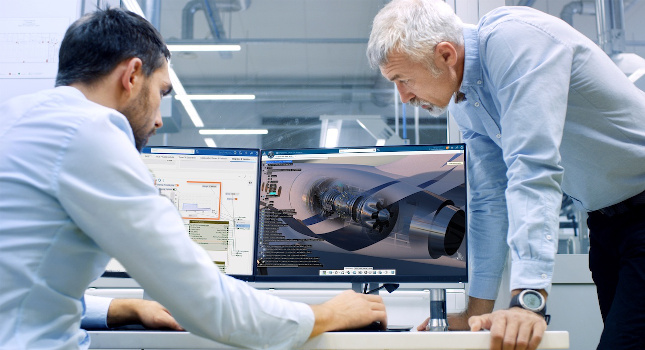Digitalization of systems engineering helps transform existing processes and restructure for automation, increase product connectivity, meet new rules and regulations and optimize operations for uncertainties.

Learning Objectives
- Systems engineering uses a model-based description of the diverse functions of different disciplines integrated within a complex system.
- Optimize operations and product lifecycle management with systems engineering.
- Linking tools and software helps traceability, systematic product development.
Digitalization means companies are increasingly concerned with transforming existing processes and restructuring established organizations. This development is spurred by the high degree of automation in modern processes, increased connectivity of products and a variety of new rules and regulations. Systems engineering creates a flexible and sustained principle of order by which enterprises can master the challenge and optimize their operations for what lies ahead.
This is useful when approaching the product development process today, which is a complex undertaking for most organizations. This is due to an increasing amount of software and electronics in different products that must be able to work together. In addition, companies must meet numerous rules and regulations to certify their products.
Improving software performance for automotive, other industries
The ASPICE (Automotive Software Performance Improvement Capability dEtermination) standard, regulates the assessment of the performance of control unit suppliers’ development processes in the automobile industry. [ASPICE is derived from the ISO/IEC 15504 SPICE standard; also see ISO/IEC TS 33061:2021 Information technology — Process assessment — Process assessment model for software life cycle processes.] Implementing such a standard can be extremely complex for a company as it must show it operates thorough and systematic product development, and as part of this traceability, all resulting tools and products must be linked.
While ASPICE may be an automotive standard, other industries face strident regulation as well. For example, in aviation there are different models of maturity a company must satisfy before its end-products can be approved.
Today, it often takes various departments of a company to develop different parts of an end-product which is then submitted for certification or approval. If feedback requires subsequent improvements, a special task force takes care of it. Following this, the development process ensues to find out exactly where improvements for obtaining certification are called for. Such a development process can be tedious and quite complex, but only can a product finally be manufactured.
For a company, this strenuous process often means dedicating a multitude of resources and losing competitive advantage. If companies are to satisfy an increasing number of rules and regulations and remain agile in how they operate, they must adapt or renew their organizational structures.
Systems engineering: Principle of order for successful digitalization
If a company wants to achieve successful and sustained digitalization, it must launch a thorough transformation process. Systems engineering is a promising principle of order in this context. The elaborate process can be implemented step-by-step, and interconnected quickly and sustainably according to the size of a company and the nature of the requirement.
The aim of systems engineering is improving cooperation through a model-based description of the diverse functions of different disciplines integrated within a complex system. The collective information from everyone involved in a project is conditioned for simultaneous processing over a unified platform. This creates a footing on which a company can digitalize its entire development process by systems engineering, while generating unified development data to offer a company a transparent data pool at the same time. Based on these centrally-held figures, a company will be able to make informed decisions answering complex questions. This will have a long-term, positive impact on product development, enabling a company to operate on a more agile scale.
Promoting sustainability for systems engineering
Systems engineering works as an enabler of sustainable development and implementation when a new product architecture is to be set up. That is especially important when developing innovative products for which a company lacks legacy experience. An example of this is an electric engine. The automobile industry may have accumulated an abundance of historical expertise when it comes to the internal combustion engine, but manufacturers are treading fresh ground in the development of electric engines. Therefore, they have to draw on methods of mechatronic simulation to develop a product that is as efficient as possible, which calls for tight cooperation between different departments possessing different types of skillsets.
Such cross-competence in product development is ideally mapped by systems engineering. This lets an industrial enterprise break down existing data silos and think tanks, showing the way to interdisciplinary cooperation not only between departments but even with business partners.
Complexity simplified for systems engineering
New challenges are emerging through the greater networking of products in the internet of things (IoT), and developments like autonomous driving, which link directly to systems development and competencies. Taking an electric vehicle as an example, users can see how encompassing and complex new products are and what a company must be prepared for. An electric vehicle will often run on batteries the manufacturer purchases from a supplier. If there are problems with batteries during the use of a vehicle, the vehicle manufacturer, rather than the producer of the batteries, is held responsible by the customer.
This makes it important for automobile companies to have reserves so they can bear the costs of possible warranty claims, but how are these best calculated? System simulations of a battery cell are needed to answer this interdisciplinary question of mechatronics. These will look at parameters like heat, electronic power, chemical composition and costs overall, from which systems engineering may present a mature and rapid approach to answering complex questions.
Systems engineering leads to new business models
During the digitalization process, companies look for new business models to change their base market. Here, you often find the expression “system of systems,” which means a unity of systems combining their capabilities and resources to form a new, greater ecosystem. This new system offers more functionality than just the totality of the single systems it is composed of. Such a development can be observed on the market for washing machines, for instance. For example, take Miele, a German company that offers a machine with two ready-filled washing powder tanks. When the washing powder is running out, a sensor signals this to the manufacturer and Miele can immediately send refills to the customer. In an ideal situation, the customer would not need to do more.
In this business model, the washing machine isn’t generating turnover, but the washing powder is. Designing such a process systematically and including its infrastructure is a highly complex competency of systems engineering. This is an impressive example of the growing complexity and connectivity of products in addition to the direct support that systems engineering can offer in such a scenario.
Systems engineering, product lifecycle, information management
Systems engineering is a promising approach for companies looking to meet the challenges of digitalization and address future market developments. Supported by a powerful business platform, a company can implement digitalization and harmonize its product development processes to meet requirements one step at a time. The platform collects all product information over the complete lifecycle, from design and development to after-sales and service, in order to manage and make it accessible across a range of disciplines.
While several companies have already integrated a systems-engineering approach as part of their corporate strategy in extensive transformation processes, it’s time for this to become standard practice to improve product development across industries.
Mark TenEyck is director of sales, Catia, Dassault Systèmes and president, International Council on Systems Engineering, Los Angeles chapter. Edited by Mark T. Hoske, content manager, Control Engineering, CFE Media, [email protected].
KEYWORDS: Product lifecycle management, control design
CONSIDER THIS
How is your product development and lifecycle management improving with integrated systems engineering?



